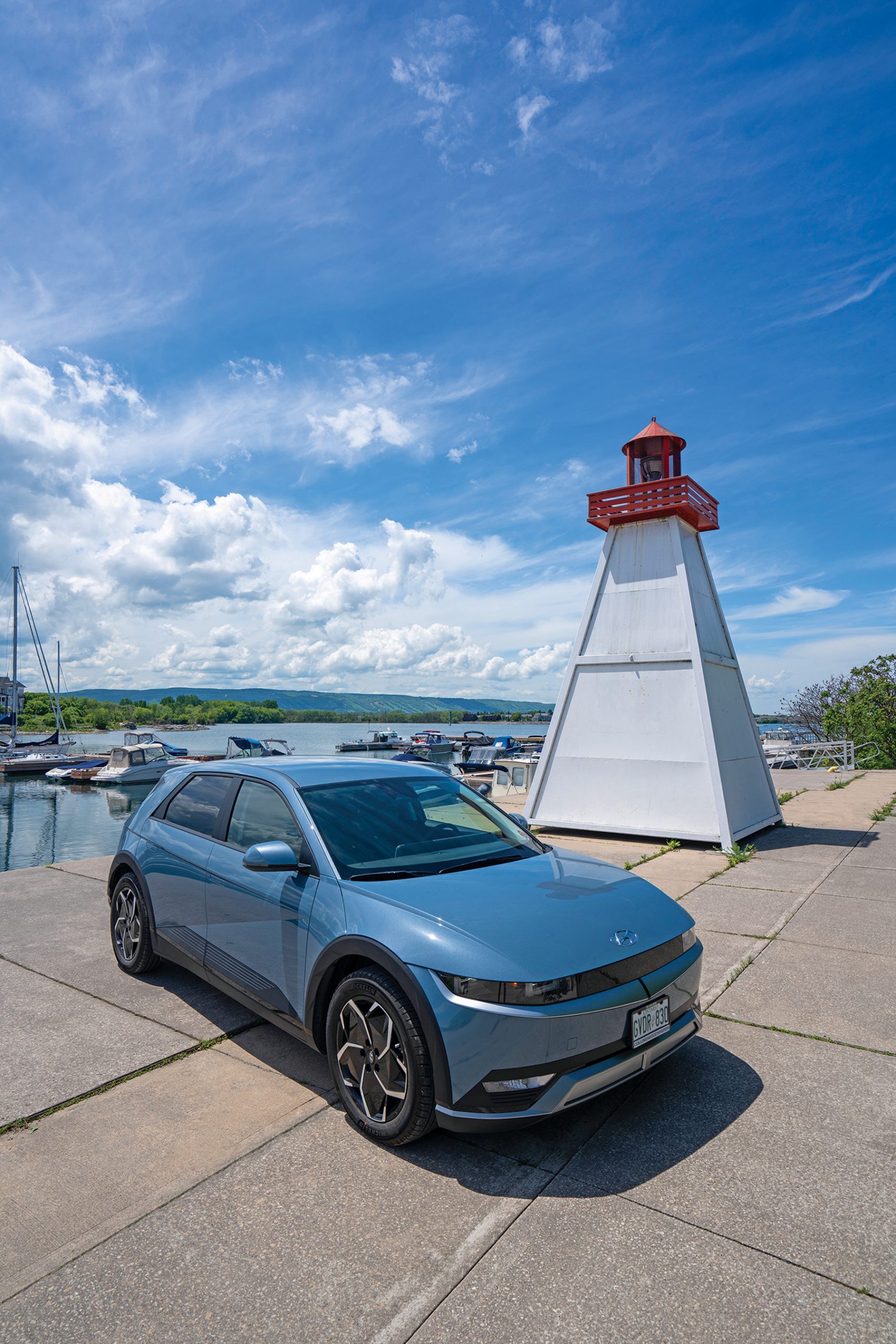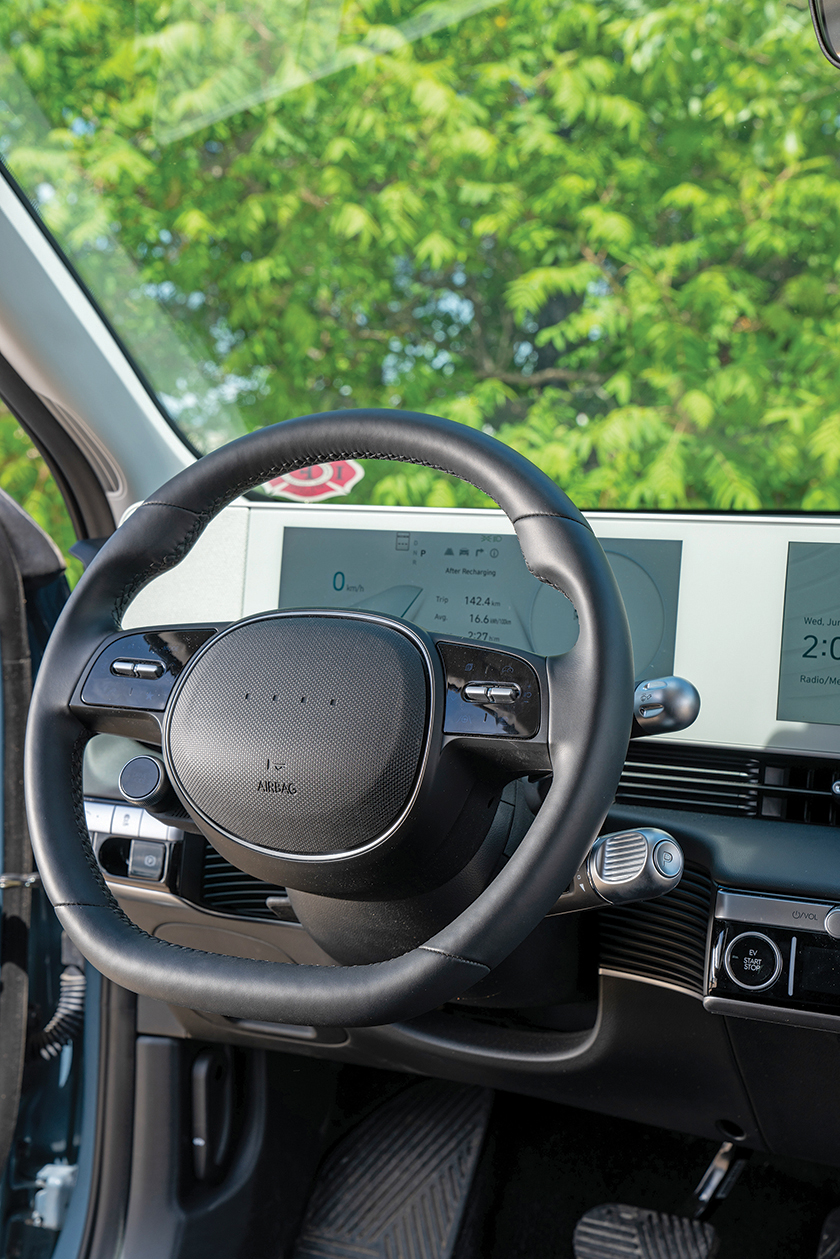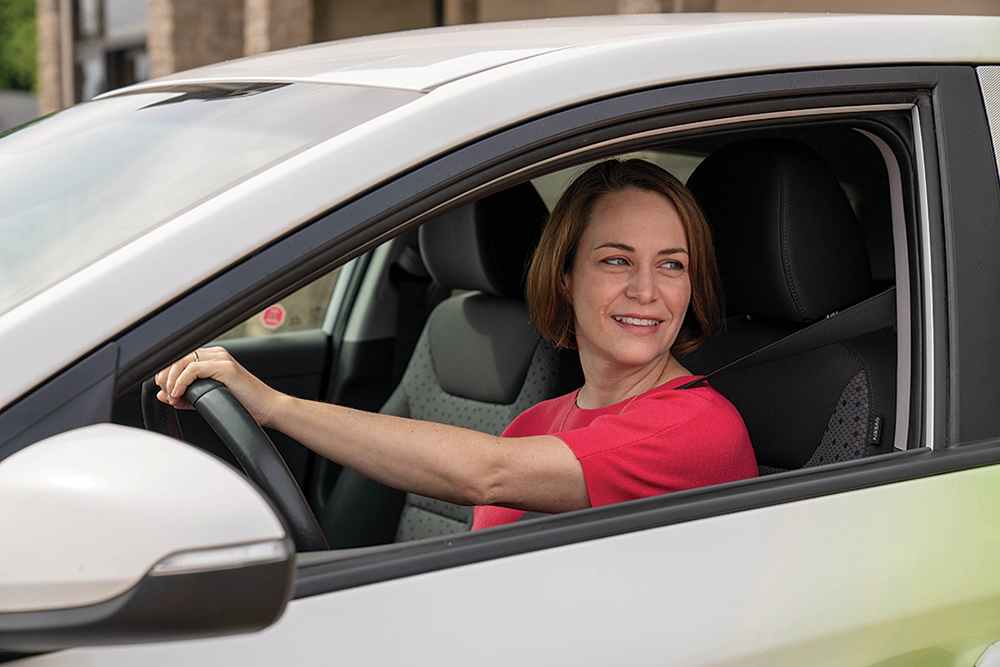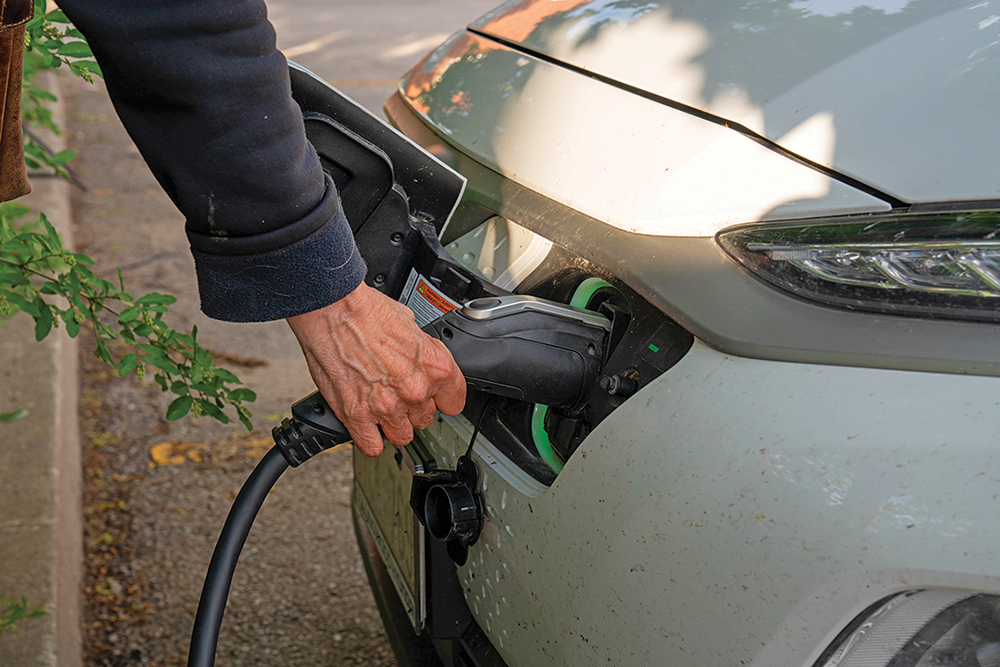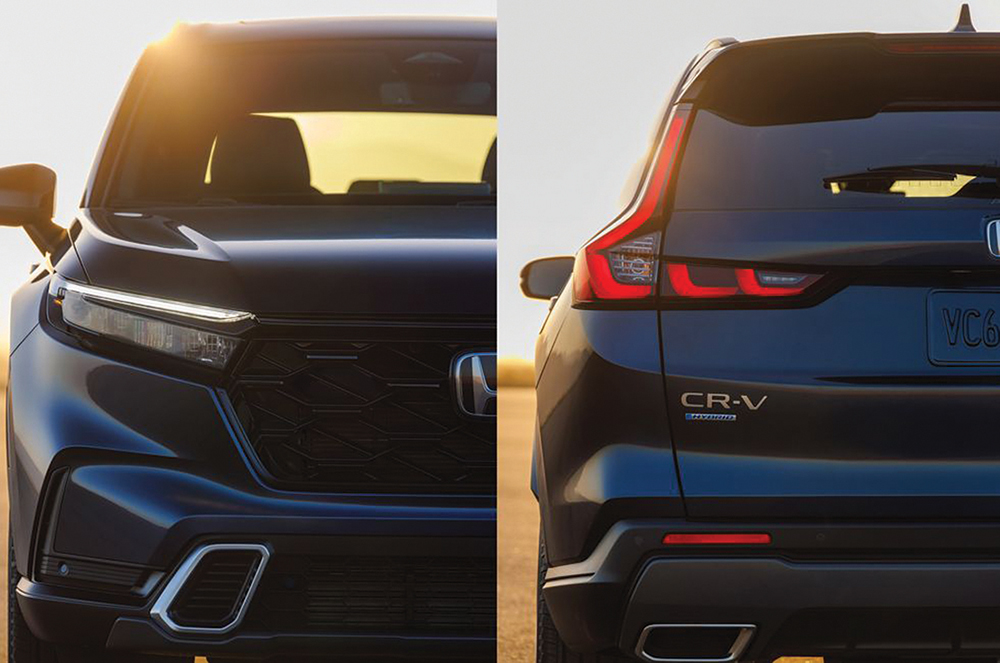No longer just for early adopters, electric vehicles offer speedy relief from the bloated price of gas—if you can find one.
by Tom Maloney // Photography by Kaiden Collver
The professional driving instructor yelled, “Brake.”
We were heading into turn one on the Algarve International Circuit in Portugal, me behind the wheel, the instructor in the passenger seat. The two lightweight electric motors powering the Jaguar I-PACE were making a sound best described as a hush. Without the guttural revving you would hear from an internal combustion engine (ICE), the lightning acceleration felt surreal. Were we really going that fast?
“Brake!” the instructor shouted a few seconds later. I hit the brakes. The instructor gasped in relief.
That experience demonstrated how electric vehicles, or EVs, have come such a long way in a relatively short period of time.
Performance, range and some prices are improving year after year.
For instance, Chevrolet introduced the Bolt in 2016 at a starting price of $42,795 ($49,966 in inflation-adjusted dollars). The 2022 version is $40,198 and range is extended by more than 20 percent, from 320 to 397 kilometres.
Only early adopters owned an EV five years ago. Today there’s overwhelming demand from a wider consumer base, spiking this summer with the gasoline prices topping two dollars a litre. Ford was so overwhelmed by demand for the electric F-150 Lightning pickup, it shut down orders for the 2022 model. General Motors is promising longer range and lower costs with a new battery technology, Ultium, with the Silverado EV pickup and other vehicles destined for the market next year.
Demand intensified such that it’s been nearly impossible to find an EV on local lots. Toyota has introduced its first battery electric vehicle (BEV), the bZ4X, but Collingwood sales manager David McArthur says it won’t go on sale in Ontario for a year and then, “We are not taking orders since we have no concrete expectation of delivery.”
McArthur says customers have waited two years for delivery of the Rav4 Prime, the plug-in version of its most popular SUV which can operate both as an EV and a hybrid. Over at Blue Mountain Honda, general manager Dayn Kramp says the electric Honda Prologue SUV will debut for 2024: “Order dates have not been released, however mid-next year would be expected.”
And so it goes.
“There’s always been a strong interest in EVs in our area but certainly as fuel prices rise, interest in more economical means of transportation has risen as well,” Mike Merrifield, sales manager of Collingwood Nissan, said in May. “I’d estimate that over the last few months, inquiries on EVs have at least doubled, maybe tripled.”
While an issue declining in importance, a major difference between a gas-powered vehicle and an EV still comes down to two words: range anxiety. Consumers may question whether EVs are practical for Southern Georgian Bay, where many drivers commute long distances to the GTA and elsewhere. Those concerns may be allayed with the upper range of today’s EVs now around 500 kilometres. But that’s in the summer. In winter cold, the range can drop as much as 40 percent. Turning down the cabin heater can reduce this loss—but are you prepared to bundle up?
“On the surface, the idea of an EV sounds appealing (but) once customers start the inquiry process and really think how this vehicle will be used in their life, it starts to become less attractive,” says Honda’s Kramp. “Range is becoming less of an issue though. The major speed bumps are charge time and availability of chargers.”
McArthur of Toyota says people need to plan ahead but, “They obviously have figured it out. It’s a lifestyle.”
As EVs use a battery rather than gasoline or diesel to transfer power to the motor, the battery must be recharged. With the fastest charger, a Level 3 such as at Tesla’s station at Keith Avenue in Collingwood, plugging in for 15 minutes will get you 320 kilometres of range. A Level 2 charger connects to a 240-volt outlet and returns about 150 kilometres of range in a few hours. Charging on a regular home outlet—Level 1 charging—will take all night and then some. Many owners pay about $2,000 to have a Level 2 charger professionally installed at their home and then “fill up” overnight when hydro rates are lowest.
Consumers may question whether EVs are practical for Southern Georgian Bay, where many drivers commute long distances to the GTA and elsewhere.
Sarah McKellar of Collingwood ordered a rear-wheel-drive Tesla Model 3 in September last year when her 2013 Hyundai Elantra passed the 300,000-kilometre mark.
“Our first range anxiety was on a weekend trip to an area in the Kawarthas without chargers,” she says. “We had the car fully loaded and bikes on the back and were driving with the flow of traffic that was quite fast. On the return to Collingwood, we got nervous about making it home.”
“The car told us that if we kept our speed below 80 that we could actually make it. We weren’t ready to take that chance and pulled into the supercharger in Barrie with seven percent battery. With a 10-minute charge—which became a Starbucks coffee and bathroom break—we were back on our way.”
As for infrastructure, local municipalities are scurrying to catch up to demand. As of June, there were only five public charging stations other than Tesla’s (currently available only to Tesla owners) between Collingwood and the Town of the Blue Mountains. Understanding that tourists will become increasingly dependent, the Town of The Blue Mountains council voted on May 31 to install more chargers at seven locations, and Collingwood is also planning more. For now in Thornbury there’s only one public charger, at the Pharmasave on Highway 26.
“We need more,” says the store’s co-owner, Shannon Fry. The 2017 Hyundai Ioniq she purchased gets about 200 kilometres on a full charge. “It’s been a great solution for local deliveries and incredible in terms of maintenance. You go through far less brake (servicing) because of the regenerative braking.”
Fry acquired the Ioniq before a federal government grant became available. Ottawa now offers grants up to $5,000 for vehicles with an MSRP up to $70,000. “We wanted to be on the forefront of change,” says Fry, who had the car painted colorfully to send a message to passersby. “It was more expensive at the time, but with fuel prices now it’s working out in our favour.”
The net environmental benefits and cost savings of EVs relative to ICE vehicles are matters of complex debate. Heavy duty mining is required to obtain the nickel, lithium and rare-earth minerals for EVs, and while manufacturers have brought down the cost of batteries, the Globe and Mail recently reported that the average premium for an EV over a similar gas-powered vehicle comes to $20,000.
On a day-to-day basis though, owners feel massive relief from the pump. Using National Resources Canada stats, AutoTrader.ca reported that the cost of a fill-up was 78 percent less for an EV, and that was back when gas cost $1.58 per litre.
As with Shannon Fry, McKellar was prompted by concerns about climate change to switch to an EV. Then there’s the unexpected bonus, as I experienced with the I-PACE on that track in Portugal.
“The biggest two items are the acceleration and one-pedal driving,” McKellar says. “There’s an instant response which makes the car lively. The car corners very well and handles the slushy, heavy snow due to the weight of the battery and low centre-of-gravity.
All in all, it feels like we went from a basic, reliable car to a fancy performance car.”
Ferdinand Porsche built the first gas-electric hybrid car, the Lohner-Porsche Mixte, in 1901. Toyota launched its green status symbol, the fuel-sipping Prius, in 1997. The first commercially available plug-in hybrid was the Chevy Volt in 2010. Nowadays most manufacturers have hybrid offerings.
“The big benefit, of course, is fuel efficiency, so it’s helping the pocketbook and the planet at the same time,” says Dayn Kramp, general manager of Blue Mountain Honda. Hybrids use roughly 25 percent less fuel than their gas-only equivalents.
Kramp says Honda’s bread-and-butter compact crossover, the ever-popular CR-V, is getting a complete redesign for 2023, and the hybrid option is coming to Canada for the first time.
“We’re taking pre-orders now and they’re due to land here later this summer. It’s reasonable to expect customers to have their vehicle this fall.”
Hybrid versions of the Honda Civic and Accord are soon to follow. Both the CR-V and Civic will be built at the zero-waste Honda plant in nearby Alliston, Ontario, an employer of many Southern Georgian Bay residents. Which brings to mind another way to shrink your ecological footprint, besides a more efficient engine—extend the “100-mile diet” philosophy to your automobile purchase and buy local.
—Tim Shuff





